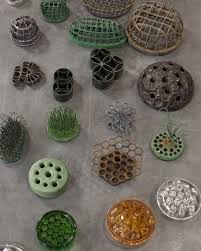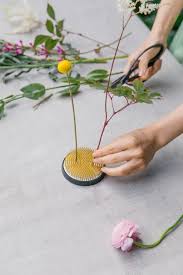What is a flower frog? If you’re unfamiliar with the term, don’t worry! A flower frog is a simple yet ingenious device used in the art of floral arrangement. It may sound like a small creature that hops around in a garden, but in reality, it’s a fantastic tool that helps create stunning and well-organized floral displays.
In essence, a flower frog is a grid-like or pin-cushion-like structure, usually made of metal or ceramic, designed to hold flower stems securely in place within a vase or a container. Its purpose is to keep flowers upright and evenly spaced, allowing for a visually pleasing and balanced arrangement.
The history of flower frogs dates back to the late 19th century when they gained popularity, especially in Japan, where they were commonly made from metal, pottery, or even glass. Over the years, their use spread worldwide as people realized the benefits they offer to floral enthusiasts and professional florists alike.
So, how does a flower frog work? It’s quite simple, actually. When you have a collection of flowers, be it from your garden or a store, you trim the stems and then insert them into the holes or spaces on the flower frog. The spikes or pins found on the frog hold the stems securely, preventing them from toppling over, crossing paths, or getting lost within the arrangement.
One of the most significant advantages of using a flower frog is its reusability. Unlike floral foam, which is commonly used in flower arrangements but is not environmentally friendly, flower frogs can be used repeatedly, making them an eco-conscious choice. Moreover, they provide better support for delicate or heavy-stemmed flowers that might otherwise struggle to stand upright in a vase.
Another remarkable aspect of flower frogs is their versatility. They come in various shapes and sizes, catering to different types of vases and floral designs. Some have a low profile, ideal for shallow containers, while others are taller and more suitable for larger arrangements. Additionally, some flower frogs are designed explicitly for specific styles, such as Japanese Ikebana or modern minimalist arrangements.
For flower enthusiasts who love to experiment, the flower frog opens up endless possibilities. You can create a symmetrical arrangement, a wild and organic display, or even a unique, unconventional design—all with the help of this unassuming tool.
Whether you’re a professional florist preparing for a grand event or a hobbyist arranging flowers to brighten up your home, a flower frog is a valuable addition to your toolkit. Its simplicity, reusability, and ability to elevate your floral creations make it a must-have accessory for any flower lover.
Additionally, the flower frog is a simple, yet ingenious device that enhances the beauty of floral arrangements. With its grid-like or pin-cushion-like structure, it securely holds flower stems in place within a vase or container, allowing for visually stunning and well-balanced displays. Its historical significance, eco-friendliness, versatility, and ease of use make it an indispensable tool for both professional florists and flower enthusiasts.
So, the next time you create a bouquet or floral centerpiece, consider using a flower frog and watch your arrangements bloom with elegance and charm.
Read Also: 9 Ways to Fatten Up your Pigs the Right Way
Types of Flower Frogs

When it comes to flower frogs, there are several types available, each catering to different vase shapes, floral arrangements, and artistic preferences. Let’s see some of the common types of flower frogs:
1. Pin Frog or Pin Holder:
The pin frog, also known as a pin holder or needle holder, is one of the most traditional types of flower frogs. It consists of a heavy metal base with small spikes or pins rising from its surface. These pins securely hold individual flower stems in place. Pin frogs are usually circular or square in shape and come in various sizes to accommodate different vase dimensions.
2. Grid Flower Frog:
The grid flower frog features a crisscrossing grid pattern made of metal or plastic. It resembles a wire mesh with evenly spaced gaps. This type of frog is suitable for creating organized and symmetrical floral arrangements. The grid structure ensures that flowers stay in place while maintaining their individual positions.
3. Cage or Basket Flower Frog:
The cage or basket flower frog consists of a wire framework in the shape of a cage or basket. It is often used in combination with floral foam to provide extra stability to the arrangement. Flowers can be inserted into the cage, and the entire unit is then placed within a vase. This type of frog is excellent for securing delicate or top-heavy flowers.
4. Ceramic or Glass Flower Frog:
Ceramic or glass flower frogs add an artistic touch to floral arrangements. They come in various shapes, such as bowls, spheres, or even intricate figurines. These decorative flower frogs have small holes or indentations where flower stems can be placed. Besides their practical use, they also serve as beautiful centerpieces or decorative elements on their own.
5. Adhesive Flower Frog:
An adhesive flower frog is a modern and versatile option. It consists of a reusable adhesive that can be stuck to the bottom of a vase or container. The adhesive has multiple small spikes or pins that hold flower stems in place. This type of frog allows for flexibility in arranging flowers in containers of various shapes and sizes.
6. Floral Frogs for Specific Styles:
Some flower frogs are specially designed for specific floral arrangement styles, such as Ikebana or minimalist designs. These frogs often have unique shapes and structures that align with the principles of the respective floral art form.
Each type of flower frog offers distinct benefits, and the choice of frog depends on the vase, the type of flowers being used, and the desired arrangement style. Regardless of the type, flower frogs remain a valuable tool for ensuring that floral displays remain elegant, balanced, and visually appealing. So, whether you’re a professional florist or a flower enthusiast, exploring different types of flower frogs can add a touch of creativity and precision to your floral artistry.
Uses of Flower Frogs

Flower frogs serve a variety of useful purposes, making them indispensable tools for floral enthusiasts and professional florists alike. Here are some of the key uses of flower frogs:
1. Floral Arrangements: The primary purpose of a flower frog is to create stunning floral arrangements. By securely holding flower stems in place, flower frogs allow for precise positioning and organization of flowers within a vase or container. This ensures that the arrangement looks balanced and visually pleasing.
2. Stability: Flower frogs provide excellent stability for flower stems. They prevent flowers from toppling over or bending, even in tall or narrow vases. This stability is particularly essential when working with delicate or top-heavy blooms that may struggle to stand upright without support.
3. Versatility: Flower frogs come in various shapes and sizes, making them versatile tools for different types of floral arrangements. Whether you’re arranging a small bouquet, a grand centerpiece, or a unique artistic display, there’s a flower frog that suits your needs.
4. Reusability: Unlike floral foam, which is commonly used in flower arrangements but can only be used once and is not environmentally friendly, flower frogs are reusable. They can be washed and used again and again, making them a sustainable and eco-conscious choice for floral artistry.
5. Ikebana and Traditional Arrangements: Flower frogs find a special place in Japanese Ikebana and other traditional floral art forms. Their precise grid-like or pin-cushion structures align perfectly with the principles of these styles, allowing artists to create beautiful and meaningful arrangements.
6. Water Efficiency: Flower frogs help conserve water by keeping flower stems in place and preventing them from splaying out. This reduces water wastage and ensures that flowers can draw water efficiently from the vase to stay fresh and vibrant for longer periods.
7. Holding Non-Floral Elements: Flower frogs are not limited to just holding flowers. They can also be used to secure other decorative elements in floral arrangements, such as branches, leaves, or even feathers, expanding the creative possibilities for unique displays.
8. Design Experimentation: For flower enthusiasts who love to experiment with different arrangements, flower frogs offer a perfect platform. They provide a stable foundation for trying out various shapes, styles, and color combinations, allowing artists to unleash their creativity.
9. Event Decorations: Flower frogs play a crucial role in preparing floral arrangements for special events, such as weddings, parties, and ceremonies. With their help, florists can create stunning centerpieces and decorations that leave a lasting impression on guests.
In summary, flower frogs are versatile, reusable, and practical tools that enhance the art of floral arrangements. From providing stability and precise positioning to enabling creative experimentation, they offer a range of uses for both professionals and hobbyists. Whether you’re arranging flowers for an event or simply adding a touch of beauty to your home, a flower frog is a valuable companion in your floral journey.
Read Also: The Power of Incineration
